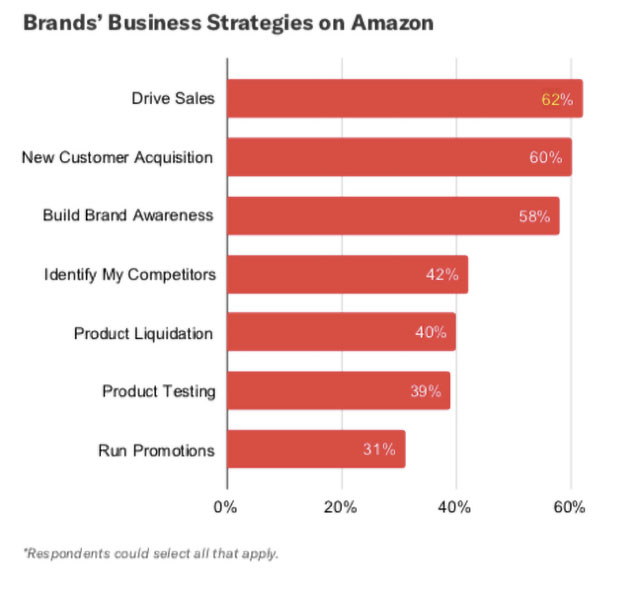
Source: Amazon
March 11, 2020
Brands have a lot of reasons for working with Amazon
According to a survey from Feedvisor, brands are looking to use Amazon.com for many reasons beyond simply selling products.
When asked about their top business strategies for Amazon, 62 percent said they use the channel to drive sales, but close behind was the need to acquire new customers, 60 percent; and to build brand awareness, 58 percent.
Outside of those three top responses related to the sales funnel, the next most important way brands are using Amazon is to “Identify My Competitors,” cited by 41 percent. When asked about their top source of competition, 37 percent of brands cited national or global brands, followed by direct-to-consumer brands (25 percent) and Amazon’s private labels (21 percent).
In this way, Feedvisor wrote that brands are looking to “receive insights on their current competitive arena, nix competitors that are not actually a threat, and truly understand who may be stealing demand or market share from them.”

Brands are also using Amazon for product liquidation, cited by 40 percent; product testing, 39 percent; and to run promotions, 31 percent.
Feedvisor’s second annual analysis, “Brands and Amazon in the Age of E-Commerce,” was based on a survey of more than 1,000 U.S. brands.
Other findings from the survey:
- Seventy-three percent of brands advertise on Amazon, up from 57 percent last year. Over half (54 percent) of brands selling on Amazon believe there is a “great deal of value” in Amazon advertising.
- Seventy-two percent of 1P Brands (Amazon acts as the retailer in the traditional wholesale arrangement) want to expand to Amazon’s 3P Marketplace (sell directly to consumers via Amazon Marketplace).
- Fifty-four percent of brands selling on Amazon said e-commerce marketplaces are their greatest source of opportunity. For nearly half (42 percent) of brands surveyed that have an Amazon presence, the platform represents more than half of their e-commerce sales.
Discussion Questions
DISCUSSION QUESTIONS: If you were a brand manager, what would be your top reasons be for selling on Amazon? Are the priorities for brands selling on Amazon similar or different than selling on Walmart, Target or any other online platform?
Poll
BrainTrust
Susan O'Neal
General Manager, Promo Intel & Insights, Numerator
Jasmine Glasheen
Content Marketing Manager, Surefront
Recent Discussions







For new brands, Fulfilled by Amazon is the most attractive and has the biggest potential reach. For emerging brands, Marketplace makes sense because they can reduce costs and put more items on sale, but it requires fulfillment capabilities at their end. For stable brands, excess inventories start piling up and first-party relationships makes sense. For such first-party products, Amazon can price whatever, so there is risk of brand dilution. This is what brands have to be most careful about.
It is all about understanding what you want to accomplish and strategizing accordingly.
The difference between Amazon and the Walmart or Target online platforms is that Amazon is a mall, Walmart and Target are retailers. The brand manager would look at them differently, just as one would look differently at having their apparel sold in Macy’s versus opening a branded store.
Why does a brand open a store in a mall or on Fifth Avenue? Yes to generate additional sales, but also for exposure and brand building.
Amazon can deliver “bottom-of-the funnel” satisfaction better than just about any other retailer – so I understand the blossoming love affair. However, “brand value” over the long-term is a function of top-of-the-funnel metrics – how much do consumers want it, ask for it, demand it REGARDLESS of the retailer – this is where *sustainable* margin and value creation happens. For new brands, Amazon’s low barrier to entry helps in both areas – they can provide momentum/readiness to expand distribution beyond e-commerce. The same isn’t true for established brands. While established brands have to meet that competition there (as the article references), to do so at the expense of the rest of the marketing funnel – to confuse bottom funnel mastery with long-term success – would be a mistake. Established brands still have to advertise above the retail funnel, even and especially with Amazon.
This survey appears to be brand managers, hooked on “Amazon increases” at high percentages, rationalizing their deals.
Does Amazon improve your brand? Nope. Not unless you pay them a lot of money to appear high in searches — and then Amazon will still place their own private label products higher.
Driving sales? Amazon returns double digit growth — but minuscule numbers in the grand scheme of things. So managers are hooked on the million or two they get from Amazon, and ignore the $50 million they get in stores.
And “new customers”? Perhaps a few. But these folks ignore that they never get to know who those new customers are — only Amazon does.
This survey is mind boggling. Manufacturers needs to find some clearer wisdom than this.
Retailers that are strategic can use Amazon as a new customer acquisition funnel. By selling a few lower priced goods on Amazon and investing in branding on the platform, retailers can drive click traffic to their e-commerce sites. All too often, I see retailers miss out on this opportunity by not taking advantage of the space allotted for their brand profile and product description—when in actuality, that’s where there’s an opportunity to funnel sales to their independent website.
First of all, outside of the high-end luxury category where product scarcity and high prices equal value, and true artisanal products with more demand than supply, what brand can afford to not sell on Amazon today? The answer? Not a whole lot. That’s the advantage of operating a marketplace rather than a store. And operating a marketplace where you let brands suffer all the margin losses associated with intense price competition and battling for awareness makes Amazon’s approach far stronger than that of any individual retailer. So yes, brand priorities do — or should — shift depending on platform. And if — and that’s a big if — Amazon is really going to fully share sales data and analytics with the brands which sell on it, it has another advantage over any retailer taking a purely proprietary approach to data.
Amazon is consumers’ new search engine, and brands are foolish not to use it as a way to connect with micro-audiences that they cannot (or cannot afford to) reach. Amazon should be a part of any brand’s marketing portfolio.
Selling on Amazon should be a priority for most brands. I say most, because there will always be an exception or two. There are two primary reasons Amazon should not be ignored. 1) Customer acquisition. More and more customers are using Amazon to discover new products. If you are not there, your certainly competitors are and will get the sale. 2) Even if you are not yourself listing your brand on Amazon, chances are, another reseller is. Unmonitored, these sellers can do a lot of damage to your brand with discounted pricing, poor product page quality, and more. At the very least, if you as a brand are not going to sell on Amazon, you need to be in touch with the resellers that are and setting a certain standard on how your product is being presented on the marketplace.